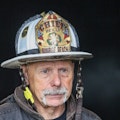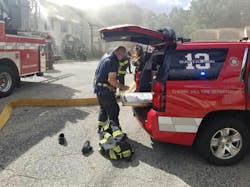For a department to perform its critical mission, competent incident commanders (ICs) are an absolute necessity. The optimal word in this statement is competent. Anyone can wear a badge or occupy the front seat of a chief’s buggy. To be capable of delivering quality service on a consistent basis, a department must ensure that it puts and keeps the right people in the right place.
Below, the critical points for officers who will assume the role of an IC and are assigned to a shift work/operational position are provided. This information should be considered capable of being molded to fit the structure, etc., of a particular department.
Characteristics
Identifying the right people begins long before the promotional process. Fire chiefs must set expectations for their ICs.
It has been said by many that what you allow becomes your standard. To ensure that the department promotes the best officers to the IC position, the fire chief must articulate the knowledge, skills and abilities that ICs must have to be promoted.
Fire chiefs should look past what often are boilerplate job descriptions that are written by a human resources specialist, to identify the necessary characteristics that lead to success on the fireground. Abilities that don’t regularly appear in job descriptions include: making difficult decisions in compressed time frames with limited information; clearly communicating in high-stress situations; using the incident management system as it applies to a given event; identifying hazardous situations and taking corrective actions; quickly resolving conflicts; and evaluating operations to lead to an effective after-action review.
Another part of this process that is often overlooked is to clearly define the identity of the organization. Many departments like to call themselves an “aggressive-attack, search-orientated organization.” This isn’t something to be taken lightly. A weak, indecisive leader is a recipe for emergency scene failure. If this is what fire chiefs identified for their organization, their ICs must be able to support this.
As the selection process for new ICs begins, it’s wise to look at the work history and reputation of those who aspire to the position.
In the past, much was made of being fair to everyone and giving everyone a chance. This equates to the fire service version of everyone getting a trophy. The process should allow participants to prove their fitness for the position. This is done, in part, through an objective review of a candidate’s past work history.
A substandard performer who is good at test-taking won’t make a good IC.
Candidates’ decision-making
Being able to communicate effectively both on and off of the fireground is an absolute for all aspiring ICs. A deep understanding of science as it relates to today’s fire service is another important quality. One tool that can be used to assess these two characteristics is a writing assignment. The question(s) that are used can be framed in numerous ways and should fit the operating profile. For example, ask candidates to draft an essay that describes the effect of UL’s Fire Safety Research Institute’s “Evidence-Based Structural Firefighting” study and how it relates to the role as an IC in the department.
Another study that applies to all departments is “Search and Rescue Tactics in Single-Family Single-Story Residential Structures.” The candidate could be asked whether present department operations support the conclusions of this study and what, if any, changes should be made to the current operating profile.
True professionalism requires an understanding of the current body of knowledge. It isn’t asking too much for ICs to be able to explain, in writing, the basis for their fireground decision-making.
Testing environment
Assessing incident management skills is a difficult undertaking. Because of the complexities of the task and the number of candidates to assess, many departments look for the most efficient way to evaluate candidates. The efficient way might be the logical choice, but that doesn’t mean that it’s the best choice.
A common approach is to use a computer-generated simulation that has one or more assessors. The assessments are done in a climate-controlled classroom setting, often with a 20–30-minute time limit. Because members of the training division normally are involved with the process and normally work the traditional staff duty day, assessments are scheduled in the morning through the afternoon. This procedure allows for the assessment to be administered fairly to all candidates and in an efficient manner for the organization.
I can’t argue with the need to be fair to all candidates, and, yes, there’s something to be said about managing the process in an efficient manner. However, I believe that leaders should look at the issue of efficiency to determine whether it overshadows the process’ capability to accurately assess candidates’ abilities to manage complex incidents. To answer this important question, I offer the following.
Test day brings a huge amount of stress with it, but does the testing environment mirror the emergency scene? Working outside, in the elements, produces stressors that one won’t feel inside of a climate-controlled classroom. To better judge a candidate’s ability to operate, I believe that some type of assessment should be conducted in a setting that’s as close as possible to an actual emergency event. Using a live fire exercise at a training center might address the gap between the classroom and fireground.
I wouldn’t conduct these exercises during extreme weather conditions, but a moderate temperature for the locality adds an extra element of stress. A temperature of 45 degrees Fahrenheit with a slight wind is a far cry from a climate controlled, well-lit classroom.
If we accept the enormity of the task that’s associated with being an IC, should we not include in the process to gain the position some of the stressors that make the job so difficult?
In addition to the environmental factors, the use of a training site adds the sights, sounds and smells of an emergency scene. Smoke coming from a burning building, engines running, saws in operation and the smell of a fire add realism and stress to the process. If candidates don’t do well in this environment, how will they handle an actual event?
I also would conduct some of these assessments at night. The testing day could start in the afternoon and run into the evening. Darkness affects all of our senses, and data tell us that a significant percentage of working fires occur during the hours of darkness.
The more that the actual conditions under which a candidate makes decisions are replicated, the better that a candidate’s ability to perform the job can be judged.
Ongoing assessment
The ability to manage a complex incident is a skill, and like any other skill, it’s subject to skill deterioration.
If you were about to board an airplane and the pilot came over the intercom and said, “Ladies & gentlemen, just so you are aware, I have not had a recertification check ride in 10 years,” you would beat a path to the plane’s exit.
Very few departments that I know require ongoing proficiency testing of their ICs. At least the pilot in the example above flies on a regular basis. ICs in suburban departments can go for an extended period without engaging at a working fire.
Departments should develop an ongoing training and assessment program for the personnel who fill the IC role. Conferences and seminars can help in this regard. The department itself can take an active role in addressing this issue. One suggestion is to hold regular meetings for command officers, where each officer must present a summary of a recent fire/emergency event. The other ICs then evaluate the presenter’s actions and provide feedback. (The medical profession has used “postmortem” meetings for decades to train doctors.)
If there weren’t any significant incidents since the last meeting, an officer could be assigned to review a National Institute for Occupational Safety and Health line-of-duty-death report with the group. The other officers would ask questions and, in a professional manner, challenge the presenter, so that individual would have to defend his/her actions/opinions.
A stiff spine is an absolute necessity for someone who makes life-and-death decisions. The final part of this training/recertification program would be to have all ICs complete and pass an emergency scene simulation. Simulations such as the one that’s described above are best, but this might be the place to incorporate computer simulations.
As important as it is to select the right people for the IC role, it is equally important to make sure that those members don’t fall victim to skill deterioration.
Complexities
None of the suggestions that’s noted above is easy to implement. The logistical issues to running such a process are immense. Contractual and personnel policy issues might very well be involved with making such drastic changes. That said, no matter how difficult a problem is, there always is an answer when a person is willing to look hard enough.
Some of a department’s current command team might have opinions similar to the ones that are expressed above. They might see solutions. Further, I never underestimate the willingness of unions to work together to increase the development of the leadership in an organization. The safety of their members depends on the abilities of the ICs. Framing this issue from that perspective might be the way to gain their assistance and support.
Maybe changing the current testing process in your department is just too big an issue to tackle. If that’s the case, is it possible to create a prospective IC development school? A simulation process could be coupled with classroom instruction on strategy & tactics, decision-making under high stress, communications management, maydays & RIT, tactical withdrawals & building abandonment, etc. This approach allows an agency to conduct multiple incident management exercises over an extended period without the pressure of grading a test and making a promotional list. Pass/fail criteria could be established, and successful completion of this program would be required to participate in a promotional process.
The success on the emergency scene is, in large part, attributed to having the right people make the right decisions. Finding those people and having them in place before the event is what successful organizations do well.
About the Author

Dennis Reilly
Dennis Reilly is a 48-year fire service veteran and retired fire chief and is the owner of The First Line Fire Service Training Company. Reilly served as the fire chief in Pittsburg, KS, and Sunrise Beach, MO, and as an assistant in North Carolina and California and retired as a battalion chief in Cherry Hill, NJ. He was an original member of New Jersey Urban Search and Rescue Task Force 1. Reilly holds a master’s degree in public administration from Penn State University and is a CFO. He has spoken at numerous events, including the Command Officer Boot Camp and the Orlando Fire Conference. Reilly is a U.S. Army veteran who served in Iraq during the Operation Desert Storm.
